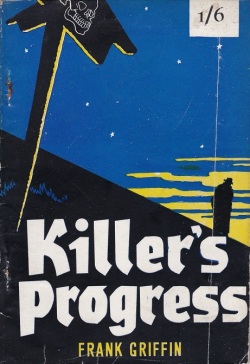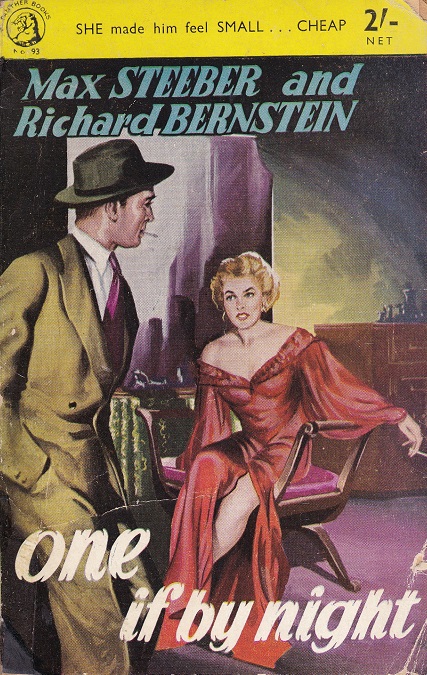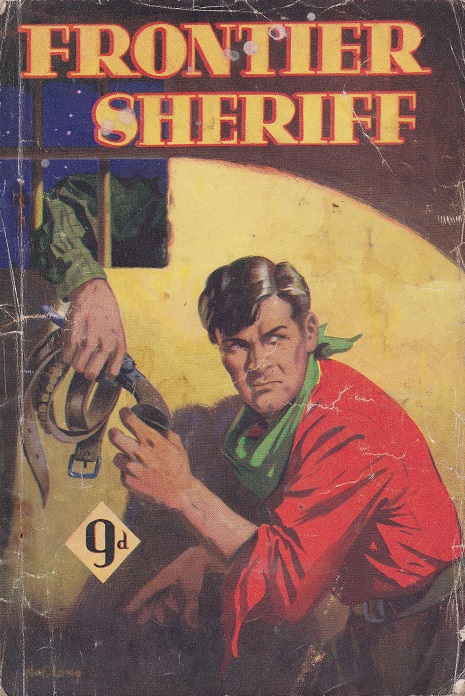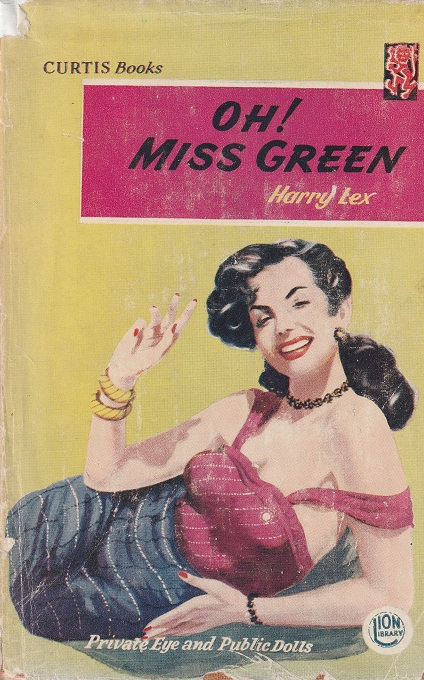
Six Gun Serenade (as noted on the cover and spine; Sixgun Serenade, as noted within) carries the byline Earle Sumner, and was published by World Distributors Incorporated, as part of their All Star Western series, likely around 1950. The artwork is signed simply “Anthon.” The novel runs from page 3 to 127. The final page lists other titles in the All Star Western Series. The interior front and rear covers are blank, wasted space. The rear cover features the following blurb for this novel:

All-in-all, the blurb reads like any other typical western of the era, however, unlike the last western I read from the All Star Western series, this one features a superb plot, plenty of action, some romantic angles, etc. All the proper elements for an enjoyable western are present.
The story actually begins with Harry Crabb rushing into bar in Green Valley in search of a friend, Paul Martin. Harry has just returned from business in Apache City, a town that sprung up once the railway lines spread West. In a bustling bar there, he runs into Garry Swift, who has some time ago been released from the penitentiary for the murder of a Green Valley resident. Seems that Swift has returned from his Eastern imprisonment to exact revenge on all the parties responsible for the murder of his father, a decade earlier.
Green Valley was accidentally discovered by Swift’s father when he was still just an infant. Part of a westward-bound caravan, Swift senior explored a vast mountain and discovered his own version of Eden. Upon returning to the caravan, he found death and destruction at the hands of roaming, rampaging Indians. While sorting through the debris for all he could salvage, he hears a noise and discovers the infant hidden, safely ensconced by its mother, his dead wife. Stricken with grief, Swift takes his infant son Garry to what he dubs Green Valley and puts his entire life into its development.
Fast-forward through the years, the government refuses to acknowledge Swift’s rights to having grub-staked the entire valley, and allots only an eighth of an acre to him and anyone else that moves in. A feud develops between he and the larger, wealthy ranchers. Eventually, he’s roped and shot dead. Then a young man, Garry Swift pursues those responsible for his father’s murder and theft of his lands. However, after he murders a local inhabitant, the local sheriff arrested Garry Swift and sent him in shackles East.
A decade later, the sheriff is dead and his son Ken Morris has become sheriff in his stead. Ken grew up with Garry and they were close friends throughout childhood, roaming throughout the valley and discovering many of its various secrets, and keeping those findings to themselves. The late-sheriff’s deputy, Happy Hogan, becomes Ken’s deputy. It is from Ken that we learn the entire backstory of Garry’s father’s past and Garry’s eventually imprisonment. After Harry Crabb’s arrival, Ken spends time in the sheriff’s office reading through old files and wonders…just who did murder Garry’s father?
Ken decides to ride out of the valley and visit Apache City, in the hopes of crossing paths with his once childhood friend, in the hopes of persuading him to move along. Eventually running into Garry, the young vigilante declares to Ken to call him “Swift.” While at the bar, much discussion ensues, but Ken finds that the hatred fills the young man’s soul and that Garry Swift intends to run hell through Green Valley.
Departing, Ken runs into a gorgeous young lady. Discovering a star attached to his chest, she assumes that he is the local sheriff, and states that a man helping her off the train apparently made off with her luggage, disappearing somewhere between the rail depot and the hotel. Ken corrects her that he isn’t the local sheriff but happy to assist her. She eventually disgorges that she has purchased an abandoned plot of land within Green Valley and is planning to develop it for the use of raising hogs.
Surprised that this lovely beauty could possibly raise hogs herself startles him but she is certain of her abilities, and has two hands coming along to assist. She also plans to locally purchase horses to be eventually brought into Green Valley. Ken hopes to meet her again one day and she invites him to visit her any time.
Pages onward contain his infatuation with the young lady, visiting her farmstead, meeting her two hands, checking out the premises, visiting some more, etc. Later, he rides back to town to discover that Garry Swift, who has been missing for weeks, after his Apache City threats, has finally resurfaced and made a mockery of the locals. They realize the sheriff has been “visiting” instead of working and he is ridiculed. Fast of temper, and easily riled, he realizes that his father would never have made his blunder.
While organizing the town towards gathering himself a posse to hunt Swift, that worthy rides into town while they are all busy listening to the sheriff expound upon his plans. He walks into the general store, ties up the owner, tosses him out back into a barrel, and sets the store ablaze.
The sheriff is made the buffoon once more; Swift outmaneuvered the sheriff. Unable to figure out how Swift keeps making his assaults and escaping sans detection, Happy Hogan finally throws into Ken’s face that its mighty peculiar that Swift showed up right when the young lady and her crew arrived. The insinuation sets Ken’s temper ablaze and the strikes down his deputy, then forks leather and goes solo to hunt the malcontent.
Deeply troubled by Happy Hogan’s suggestions, Ken realizes that his deputy may well have stumbled onto the truth, but then dismisses the entire premise as fantasy. Having searched the valley all through the night, by morning, he is exhausted, and finds himself near the young lady’s property. Deciding to drop in, he is well-received and while she prepares coffee and a meal for him, she admonishes him for overworking and suggests he rest. This he does, slipping into a brief slumber. Reawakening, he departs, but not until after he lands a kiss on her. She’s shocked by the kiss, doesn’t appear to know how to react, but then alludes that she’s a lot on her mind, and seems happy.
He rides off into NeverLand, his thoughts in the clouds, day-dreaming about the girl, when, miles down the dirt path, a rope swishes down from above, and unseats the sheriff from his horse. Deposited roughly upon the turf, he attempts to extricate himself when Swift removes his hardware. Leaving him thus trussed, and firmly secured, he confiscates the gun, tosses it onto the horse, and tells Ken to start walking all those long miles back to town.
Swift’s intention is to humiliate Ken, and it works. He could walk back to the girl’s ranch, but he realizes he could never live down the shame. So, he decides to hoof it into town, hoping to sneak in under cover of darkness, and get Happy Hogan to release him. Life doesn’t work out that way. He trips, stumbles, falls, can’t get up, when a wagon rolls up and those aboard recognize the rolling dirty mess as their missing sheriff. Laughing hard at his discomfiture, he declines an offer to ride into town, deciding to finish the walk as intended. They ride on ahead, to share their newfound knowledge…
Realizing his career is doomed, he turns in his star right before the townspeople demand his resignation. Gathering some of his worldly goods, he boards his horse (which walked into town after Swift released it) and departs the valley, heads over the pass and out to Apache City.
There, he gets into a near-drunken brawl with some barflies, desiring to take his anger out through use of his fists. The city sheriff drags him away, thinks about charging him $200 for disorderly conduct, but decides the people in that particular bar needed shaking up, and charges only half the rate. Ken pays up, and sleeps off his fury…but not before asking the sheriff a question. Does the sheriff recall seeing the pretty girl?
Why, yes! In fact, he assisted her off the train and carried her luggage to the hotel for her.
Ken is gobsmacked. When he first had met her, she lied to him, claiming an unknown man carried her luggage and she never saw it again. What’s more, she HAD to know the man was the sheriff, and pretended that Ken, seeing he had a star on HIS chest, was the local sheriff. Yet, the Apache City sheriff stated clearly that he had informed her that HE was the sheriff.
Realizing that Happy Hogan may well be 100% correct, Ken follows up his inquiry with one more: how many horses did she locally purchase? He knows the farmstead has 14; he’s informed they purchased 15. Now he knows how Swift obtained a horse without being seen to cross the valley’s pass. She gave it to him.
Mentally destroyed by this information, he purchases a railway ticket, bound East, when he suddenly hears news that a major rancher was gunned down, and, another was shot but not dead. Learning that they were involved in the possible death of Swift’s father, and being close friends of his, he realizes that Swift has gone from prankster, to murderer. He must be stopped. However, he does not inform anyone of his intentions to remain. Instead, he leaves Apache City and rides away for several miles, before eventually checking his back trail, then circles wide, and enters the valley from a little-known pass.
What transpires next is guts. Under cover of darkness he crashes the girl’s ranch, finds that one of the hands is standing guard, knocks him out with his gun, and walks into the home, to find her. She is in a state of shock, seeing Ken standing there. Mortified, she doesn’t utter a word. He demands the truth and she confesses to everything, but firmly notes that Swift never murdered or shot those men, lest they tried to shoot him. She promises she forced him to not murder, and Swift is a man of his word.
Ken thinks a decade changes a man while incarcerated, that his promise means nothing. The other hand (Brent) sneaks in behind him, gun leveled. The girl orders him to drop his gun, not to harm the sheriff. Brent is ordered to ride with Ken to search for the missing Swift, and prove his innocence. While riding to town they discover a badly wounded Happy Hogan, shot via a rifle bullet, and badly battered. He mumbles a couple seemingly incoherent words, but they are enough for Ken to ascertain who might be the culprit behind the whole charade.
Realizing that Happy Hogan is knocking at Death’s door, he sends Brent along with the unconscious deputy onward to town to fetch the doctor. Ken swings his horse towards a ranch (on the off-chance anyone DOES own a copy, and wants to read the book, I won’t divulge the identities the villains) and pays them a visit. The boss isn’t home, his tophand answers the knock, demands to know why Ken wants to see the boss. Ken refuses to cop a reply, departs, but swings into shelter far away to watch the ranch’s proceedings. Many hands later depart, then, the tophand fetches his horse and rides into the opposite direction, up into the mountainous region.
Ken’s convinced he is paying the boss a visit, and at a discreet distance, follows the man up until he loses his trail. Backtracking, he discovers the cliche cleft between boulders, rides through, discovers a hidden cabin. Watching, he decides that Swift may be inside, a captive. But when the boss, tophand, and one other make to depart, Ken is left in a precarious position. He can’t get his horse to back out fast enough to escape their departure, so, he discovers another recess in the rocks, deeply shadowed, and muzzles his horse. The trio pass him undetected; after a good pause, he slowly moves out of hiding, and breaking into the cabin, discovers Swift tied up, ropes tied firmly to his thumbs, holding his suspended in the air, stretched, barely able to suspend himself on his tippy-toes.
Cutting him down, Swift collapses in a heap and deliriously realizes he’s been rescued by his childhood friend. Shots ring out and Ken realizes he blundered; while they may have passed him in the rocks, upon exiting the cleft, they would have seen the extra set of horse prints! Trapped inside the cabin with a seemingly beaten and battered Swift, he sets himself up to fight to the death. Swift proves more worthy than believed, and obtaining a six-gun, assists in holding off their assailants, when, inexplicably, the roof of the cabin begins to shudder…under the impact of numerous boulders loosed from above. Noting that the roof will soon cave in, they begin to panic, but the outlaws have other plans. Now that the roof has been breached, they’ve set the top afire!
Holding out as long as possible, the pair realizes they’ll have to abandon the smoky, blazing inferno. Exiting and firing on the run, they’re mystified to receive zero in return. The outlaws have vanished! Why? They soon discover that Brent has returned with a posse, and that those on the rocks atop must have seen them from far away. Likewise, the posse sees the smoke from the fire and have their bearings.
Boarding their own respective horses, they exit the hiding place and meeting up with the posse, quickly swap details and fork leather to pursue the remaining pair of villains: boss and tophand gunslinger, who we learn from Swift had confessed to murdering his father all those years ago!
Spotting the pair as tiny black dots in the distance making for a cave and underground river system, they barricade the pair inside and decide to maintain a safe distance, with the intention of outlasting them. Swift and Ken, meanwhile, from their childhood days of exploration, recollect higher up the mountain a tiny shaft in the rocks that’ll allow them to drop down above the pair, but it’s a dangerous descent without ropes and light to guide them. Rounding the top, they find the hole covered by a huge spider web and realize that the pair inside the cave likely aren’t aware of this secret entrance, as the web would be destroyed. Picking the web aside, they enter, only to have tragedy ensue.
One of the pair slips down the rocks and falls into the water, which itself is a death-trap, sucking everything down and under the ground, and out again to an unknown source (earlier in the novel a bunch of steers were forced down that river to their death). Both battered from their own respective falls eventually do get the better of both villains. No sense ruining the quick action for you. The whole book is loaded with great action sequences.
Story ends with both Swift and Ken carted away, shot, battered, unconscious, to recover in town. Waking up, Ken eventually finds Swift gone and learns from the girl that he has left, for good. He’s also given up his “claim” on the girl, who he was to marry, but discovers that she is in love with Ken. The townspeople forgive the girl for his cooperation in the Swift shenanigans, she offers Ken a job on another newly acquired ranch. Gaping, he can’t believe she wants him to be her tophand, when she clarifies: “Do I have to ask you to marry me?…I’m asking you to be Boss…and I want to be the first to carry the new brand.”
A damn fine novel, only, a damn shame that I do not know who the actual author is! If anyone possesses information towards solving the identity of Earle Sumner, I would be grateful.
 Published 1949 by Hamilton & Co., Desert Intrigue sports a charmingly romantic cover illustration by noted English artist Reginald Heade. The novel is penned by the pseudonymous Earl Ellison; that alias was, up until his untimely death, 100% written by N. Wesley Firth. Originally simply born as Norman Firth, he adopted the “Wesley” after his own father passed away. Firth was incredibly prolific and required the need to adopt numerous nom de plumes in order to have his fiction simultaneously published.
Published 1949 by Hamilton & Co., Desert Intrigue sports a charmingly romantic cover illustration by noted English artist Reginald Heade. The novel is penned by the pseudonymous Earl Ellison; that alias was, up until his untimely death, 100% written by N. Wesley Firth. Originally simply born as Norman Firth, he adopted the “Wesley” after his own father passed away. Firth was incredibly prolific and required the need to adopt numerous nom de plumes in order to have his fiction simultaneously published.







